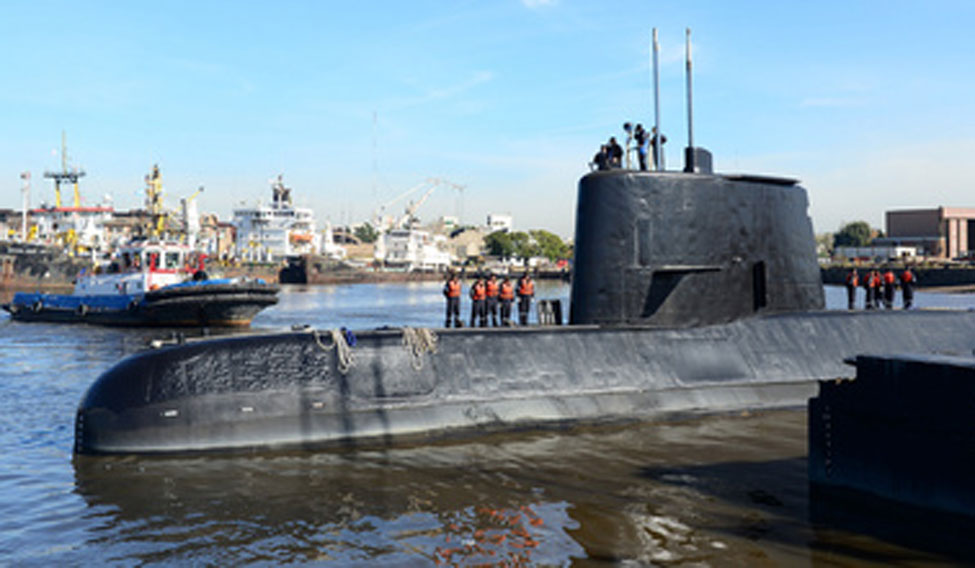One of the most harrowing experiences for any navy is the loss of contact with a submarine when it is out in the deep oceans on operational duties and having to trigger the ‘sub miss’ protocols.
Various exigencies can cause this loss of contact with a submarine at sea and while preparing for the worst case scenario, the lives of the crew members is the highest priority in the search and rescue (SAR) effort.
The Argentine Navy has been going through this nightmare for the last three days since its diesel submarine the San Juan (S-42) went ‘missing’ in the southern Atlantic Ocean. The boat has remained incommunicado for almost 72 hours. This is disturbing and while a multi-nation SAR effort is being mounted, the signs are not encouraging. Bad weather conditions in the area is hampering the surveillance effort.
The SAN JUAN was acquired from the then West Germany in the mid 1980s and at a time when Argentina (coming out of the ignominy of the 1982 Falklands war with UK) was keen to acquire a credible submarine capability. An indigenous sub building programme in Argentina was also envisaged.
But in all too familiar pattern with middle-income nations that India can relate to, the sizable fiscal investment in submarines and related infrastructure and domestic political turbulence lead to the closure of the submarine programme. So, instead of a total of six ‘boats’—of which four were to be built in Argentina—only two SANTA CRUZ type 1,700 submarines were inducted.
Submarine operating nations ought to have the appropriate deep submergence rescue vessel (DSRV) in the event of any mishap. However, not all navies that are submarine capable have this rescue capability and both Argentina and India are in this category. Consequently, in the current effort to locate the San Juan, many nations are contributing their platforms – including the USA, UK and Chile. One hopes that there will be some reassuring news about the San Juan – but it is still a case of ‘fingers crossed’, while preparing for the worst and hoping for the best.
The correspondence of the San Juan experience with the Indian Navy (IN) is instructive. It is a matter of considerable disquiet that for a country whose navy will be celebrating the 50th anniversary of the submarine arm in early December, the IN still does not have an appropriate DSRV. The need for such a capability has been highlighted by the naval apex for the last two decades, but it was only in 2016 that the approval and budgetary sanction was finally accorded. After considerable vacillation, a Rs 2,000 crore contract has been awarded to a UK firm and the first platform is expected to be delivered in late 2018.
The Indian submarine trajectory over the last 50 years has many valuable policy lessons for India’s higher defence management organisation – both at the political and bureaucratic levels. Beginning with former prime minister Jawaharlal Nehru’s disdain for the submarine as a platform, to the first acquisition from former USSR (the INS Kalveri was commissioned on December 7, 1967) and the commendable success achieved with the INS Arihant – India’s own indigenously designed and built nuclear ‘boat ‘ – the IN’s submarine saga has its fair share of trials , tribulations and distinctive professional triumph.
The IN has had its share of submarine accidents and incidents and the loss of precious lives. Many policy inadequacies that have had a detrimental impact on the submarine arm need to be identified and objectively reviewed. In the current instance, the San Juan anxiety should serve as a wake-up call for the Indian higher defence organisation.
 C. Uday Bhaskar
C. Uday Bhaskar
One question that must be probed is the cost to the nation – for delayed decision-making at the political and bureaucratic level. What would the DSRV have cost India in early 2000 and what is India paying now ? And God forbid, but in the event of a sub mishap, who would have been held accountable for the void in DSRV capability?
These are issues that must be deliberated in parliament in an informed and objective manner but that remains the elusive Holy Grail in the world’s largest democracy! In the interim, one prays for the safety of the San Juan crew.





